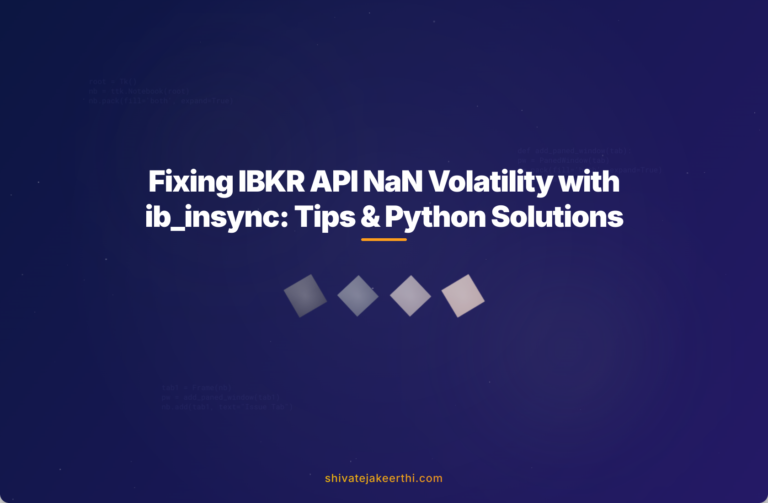If you’ve ever worked with Interactive Brokers’ API (IBKR API) using Python tools like ib_insync, you might have encountered an annoying issue: Implied volatility returning NaN values. Especially when using the asynchronous method provided by ib_insync (ib_async). This is a frustrating problem for traders and developers because implied volatility is a crucial metric for evaluating options pricing and assessing market sentiment.
Interactive Brokers’ API, combined with ib_insync, provides a convenient way to access real-time market data like prices, trading volume, bid-ask spreads, and implied volatilities. Implied volatility specifically indicates the market’s anticipated future volatility of a security. Unfortunately, sometimes retrieving implied volatility through these tools unexpectedly results in NaN (Not-a-Number) values.
Let’s explore why this might occur, how various requesting methods might influence the results, and a few strategies for troubleshooting.
Requesting Ticker Data Using ib.reqTickers
First, consider how we usually request market data using ib_insync. One common method is using the ib.reqTickers() function, which allows retrieving market data on-demand with a simple call.
Here’s a quick example showing how to retrieve option ticker data using ib.reqTickers():
from ib_insync import IB, Option
ib = IB()
ib.connect('127.0.0.1', 7497, clientId=1)
# Example option contract
option_contract = Option('AAPL', '20240419', 175, 'C', 'SMART')
# Fetch market data once
ticker = ib.reqTickers(option_contract)[0]
# Check implied volatility
print('Implied Volatility:', ticker.modelGreeks.impliedVol)
Unfortunately, even when executing this straightforward approach, the returned data can still unexpectedly show implied volatility as NaN. Here’s a typical sample output:
Implied Volatility: nan
Clearly, if you’re expecting accurate implied volatility data, this issue is puzzling. So, let’s check an alternative method to confirm if the problem persists.
Using ib.reqMktData to Get Live Market Data
Another method involves subscribing to continuous market data streams with ib.reqMktData(). This approach often gives more timely, dynamic data feeds. Here’s a brief look at how you might request live market data for multiple tickers:
from ib_insync import IB, Option
ib = IB()
ib.connect('127.0.0.1', 7497, clientId=2)
contracts = [
Option('AAPL', '20240419', 170, 'C', 'SMART'),
Option('MSFT', '20240419', 400, 'P', 'SMART')
]
for contract in contracts:
ib.reqMktData(contract, '', False, False)
def onPendingTickers(tickers):
for ticker in tickers:
print(f'Symbol: {ticker.contract.symbol}, IV: {ticker.modelGreeks.impliedVol}')
ib.pendingTickersEvent += onPendingTickers
ib.run()
Even with this subscription-based data retrieval, the problem sometimes remains. Here’s an example of the frustratingly persistent output:
Symbol: AAPL, IV: nan
Symbol: MSFT, IV: nan
Again, implied volatility data is unavailable—despite the real-time streaming subscription! Now we’re facing consistently NaN values for implied volatility, irrespective of the method we use. So, what could be causing this?
Analyzing Both Methods
Comparing both requests via ib.reqTickers and ib.reqMktData reveals that the data retrieval method isn’t the primary issue—the implied volatility continues returning NaN.
One noticeable pattern is the consistency of NaN, especially for certain ticker types or specific strikes and expirations. This strongly suggests a deeper underlying reason unrelated directly to request methods.
Possible Reasons for Persistent NaN Values
Here are a couple of plausible explanations for why implied volatility remains unavailable (NaN):
- Delayed or Unavailable Data from IB Servers: Sometimes IBKR takes time to calculate implied volatilities, especially when dealing with less liquid, thinly traded options. If the market lacks enough data points, IB simply can’t compute implied volatility immediately.
- Insufficient Subscription Duration: Implied volatility calculations can require extended periods of continuous subscription to gather sufficient data. In other words, sometimes NaN values temporarily appear until IBKR’s servers provide adequate data.
- Special IBKR Constraints: IBKR’s API documentation mentions occasional unavailability of model Greeks data, including implied volatility, for certain asset types, specific contracts, or less common expiration dates.
Understanding that IBKR might have unique restrictions or calculation delays can reassure you that NaNs might not indicate a coding error but rather limitations on IBKR’s side.
Troubleshooting Steps and Solutions
Fortunately, there are practical strategies to help improve data reliability when obtaining implied volatilities:
- Extend the Duration of Data Requests: Give IBKR servers enough time to provide accurate implied volatility data by subscribing continuously—even up to several minutes. Longer waiting periods often resolve temporary NaNs.
- Request Data During Regular Trading Hours: Model Greeks data, like implied volatility, tends to be more accurate and available during active market periods. During after-hours sessions, volatility data often remains elusive or sparse.
- Filter Contracts Carefully: Concentrate on actively traded, liquid option contracts (Python scripting can help automate this filtering easily). Typically IBKR provides faster and clearer volatility calculations for popular tickers like AAPL, MSFT, GOOG, and SPY.
- Check API Documentation: Always reference IBKR’s official API documentation to understand potential quirks related to implied volatility data. IB regularly updates docs with known issues, explaining occasional discrepancies.
- Community Resources and Forums: Sites like Stack Overflow and ib_insync’s community forums offer practical, real-world insights from other traders experiencing similar issues.
Experimenting with these actions often resolves—or at least alleviates—the persistent NaN problems you’ve been facing.
When the Problem Persists
Unfortunately, even after applying all the troubleshooting techniques discussed, some traders continue experiencing periodic NaN implied volatility. In such cases, consider alternative sources for implied volatility data, such as integrating external data providers or third-party calculation libraries like QuantLib.
External pricing models might fill the gap where IBKR struggles, especially if accuracy in implied volatility is crucial for your trading strategy or model.
Share Your Approach!
Have you found another solution or workaround to the persistent NaN implied volatility values when using IBKR and ib_insync? Your experience could significantly help others. Consider sharing your insights below or suggesting alternative approaches!
Understanding and overcoming these data retrieval nuances is vital for effectively using IBKR and Python-based tools like ib_insync. By collaborating and sharing tips, we can effectively manage or circumvent such obstacles and keep our data-driven decision-making right on track.



0 Comments